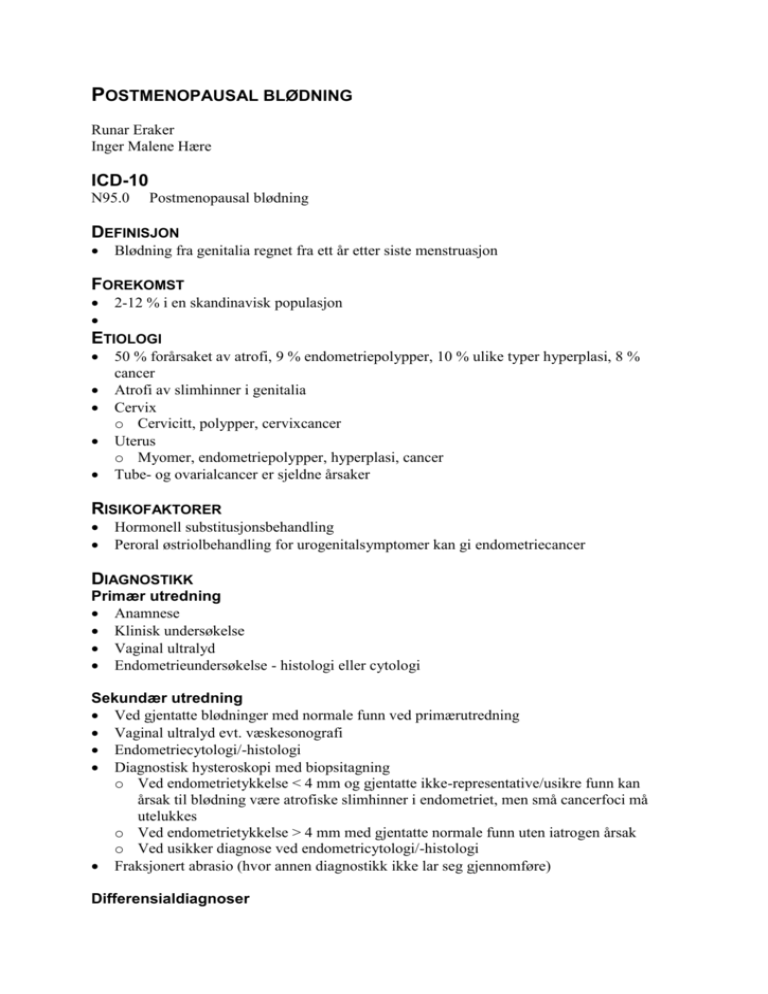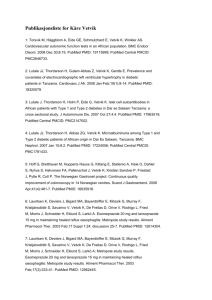Postmenopausal blødning
advertisement

POSTMENOPAUSAL BLØDNING Runar Eraker Inger Malene Hære ICD-10 N95.0 Postmenopausal blødning DEFINISJON Blødning fra genitalia regnet fra ett år etter siste menstruasjon FOREKOMST 2-12 % i en skandinavisk populasjon ETIOLOGI 50 % forårsaket av atrofi, 9 % endometriepolypper, 10 % ulike typer hyperplasi, 8 % cancer Atrofi av slimhinner i genitalia Cervix o Cervicitt, polypper, cervixcancer Uterus o Myomer, endometriepolypper, hyperplasi, cancer Tube- og ovarialcancer er sjeldne årsaker RISIKOFAKTORER Hormonell substitusjonsbehandling Peroral østriolbehandling for urogenitalsymptomer kan gi endometriecancer DIAGNOSTIKK Primær utredning Anamnese Klinisk undersøkelse Vaginal ultralyd Endometrieundersøkelse - histologi eller cytologi Sekundær utredning Ved gjentatte blødninger med normale funn ved primærutredning Vaginal ultralyd evt. væskesonografi Endometriecytologi/-histologi Diagnostisk hysteroskopi med biopsitagning o Ved endometrietykkelse < 4 mm og gjentatte ikke-representative/usikre funn kan årsak til blødning være atrofiske slimhinner i endometriet, men små cancerfoci må utelukkes o Ved endometrietykkelse > 4 mm med gjentatte normale funn uten iatrogen årsak o Ved usikker diagnose ved endometricytologi/-histologi Fraksjonert abrasio (hvor annen diagnostikk ikke lar seg gjennomføre) Differensialdiagnoser Blødninger fra urinveier og tarm VENTETIDSGARANTI Cancermistanke - utredning innen 2 uker BEHANDLING Vaginal atrofi - lokal østrogen Hyperplasi - se ”Endometriehyperplasier” Endometriepolypp - fjernes kirurgisk Cancer - se ”Endometriecancer” Iatrogene (hormoninduserte) - seponere eller justere behandling OPPFØLGING I henhold til funn og tiltak KOMPLIKASJONER Anemi ved langvarige blødninger PROGNOSE Avhenger av diagnose PASIENTINFORMASJON Screeningprogrammet mot livmorhalskreft følges til fylte 70 år Blødning mer enn ett år etter siste menstruasjon bør utredes Kontinuerlig kombinert hormonbehandling som medfører blødning de første 3-4 månedene trenger ikke nærmere utredning LITTERATUR 1. Gredmark T, Kvint S, Havel G, Mattsson LÅ. Histopathological findings in women with postmenopausal bleeding. Br J Obstet Gynaecol 1995; 102: 133-6. PubMed 2. Lethaby A, Suckling J, Barlow D, Farquhar CM, Jepson RG, Roberts H Hormone replacement therapy in postmenopausal women: endometrial hyperplasia and irregular bleeding. [Journal Article, Review] Cochrane Database Syst Rev 2004; (3):CD000402. Cochrane 3. Gupta JK, Wilson S, Desai P, Hau C. How should we investigate women with postmenopausal bleeding? Acta Obstet Gynecol Scand 1996; 75: 475-9. PubMed 4. Weiderpass E, Baron JA, Adami HO, Magnusson C, Lindgren A, Bergstrøm R, Correia N, Persson I. Low-potency estrogen and risk of endometrial cancer: A casecontrol study. Lancet 1999; 353: 1824-8. PubMed 5. Karlsson B, Granberg S, Wikland M, Ylostalo P, Torvid K, Marsal K, Valentin L. Transvaginal ultrasonography of the endometrium in women with postmenopausal bleeding-a Nordic multicenter study. Am J Obstet Gynecol 1995; 172: 1488-92. PubMed 6. Briley M, Lindsell DR. The role of transvaginal ultrasound in the investigation of women with post-menopausal bleeding. Clin Radiol 1998; 53: 502-5. PubMed 7. Fistonic I, Hodek B, Klaric P, Jokanovic L, Grubisic G, Ivisevic-Bakulic T. Transvaginal sonographic assessment of premalignant and malignant changes in the endometrium in postmenopausal bleeding. J Clin Ultrasound 1998; 26: 280-1. PubMed 8. Weber AM, Belinson JL, Bradley LD, Piedmonte MR. Vaginal ultrasonography versus endometrial biopsy in women with postmenopausal bleeding. Am J Obstet Gynecol 1997; 177: 924-9. PubMed 9. Van den Bosch T, Vandendael A, Wranz PA, Lombard CJ. Endopap-versus Pipellesampling in the diagnosis of postmenopausal endometrial disease. Eur J Obstet Gynecol Reprod Biol 1996; 64: 91-4. PubMed 10. Garuti G, Sambruni I, Cellani F, Garzia D, Alleva P, Luerti M. Hysteroscopy and transvaginal ultrasonography in postmenopausal women with uterine bleeding. Int J Gynaecol Obstet 1999; 65: 25-33. PubMed 11. Baskett TF, O´Connor H, Magos AL. A compehensive one-stop menstrual problem clinic for the diagnosis and management of abnormal uterine bleeding. Br J Obstet Gynaecol 1996; 103: 76-7. PubMed 12. Nasri MN, Shepherd JH, Setchell ME, Lowe DG, Chard T. The role of vaginal scan in the measurement of endometrial thickness in postmenopausal women. Br J Obstet Gynaecol 1991; 98: 470-5. PubMed 13. Bakour SH, Dwarakanath LS, Khan KS, Newton JR, Gupta JK. The diagnostic accuray of ultrasound in predicting endometrial hyperplasia and cancer in postmenopausal bleeding. Acta Obstet Gynecol Scand 1999; 78: 447-51. PubMed 14. Timmermans A, Gerritse MB, Opmeer BC, Jansen FW, Mol BW, Veersema S. Diagnostic accuracy of endometrial thickness to exclude polyps in women with postmenopausal bleeding. J Clin Ultrasound. 2008 Jun;36(5):286-90. PubMed 15. Angioni S, Loddo A, Milano F, Piras B, Minerba L, Melis GB. Detection of benign intracavitary lesions in postmenopausal women with abnormal uterine bleeding: a prospective comparative study on outpatient hysteroscopy and blind biopsy. The Journal of Minimally Invasive Gynecology January 2008 (Vol. 15, Issue 1, Pages 8791) PubMed 16. Timmermans, A, van Doorn LC, Opmeer BC, Kroeks MV, Duk MJ, Bouwmeester AM, Kruitwagen RF, Dijkhuizen FP, Mol BW. Follow-up of women after a first episode of postmenopausal bleeding and endometrial thickness greater than 4 millimeters. Obstet Gynecol 2008 Jan;111(1):137-43. PubMed
